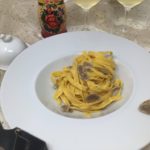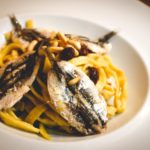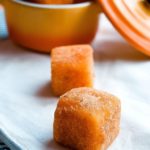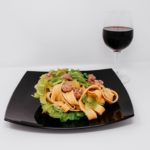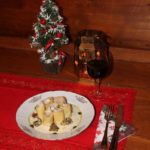SAVORY CHERRY TOMATOES TARTE TATIN
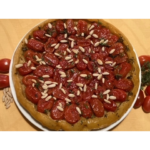
This cherry tomatoes Tarte Tatin is a very intriguing and tasty appetizer which gives a new perspective to a typical Italian ingredient. in these last years, in Italy too there was the introduction of the recipe of the Taste Tatin with its fascinating story as one of the many masterpieces that was created by a mistake.
There are different versions in Italy, since many decided to replace the sweet apples with confit cherry tomatoes and the crisp pastry, in which Parmigiano cheese and thyme combine to make this heavenly Italian appetizer.
I copied this recipe from a brilliant blogger, one of the best in Italy, Sonia Peronaci and if we follow the instructions you can make it perfectly every time.
In case you need to serve it to a celiac person or want to try a variation with spring onions there is an interesting variation in the blog.
Bring it to room temperature before serving.
Prep Time: 30 mins | Cooking Time: 35 mins | Yield: it serves 4.
Ingredients
Ingredients for a 26 cm (10 inch) diameter cake tin, 3-4 cm (2-2,5 inch) high
For the savory shortcrust pastry
- 250 g (2 cups) multi-purpose flour
- 40 g (1,4 oz) Parmigiano Reggiano, grated
- 140 g (5 oz) unsalted butter, very cold
- 1 medium egg
- 6 thyme sprigs
- salt and pepper to taste
For the filling
- 650 g (1,5 lb) red cherry tomatoes
- 20 g (1 + 1/2 tbsp or 0,7 oz) white sugar
- 1 clove garlic
- 4- 5 thyme sprigs
- salt and pepper to taste
- 15 g (0,5 oz) pine nuts
Preparation
The savory shortcrust pastry
In a food processor, add flour and cold butter into small piecesand blend for a few moments until the butter is reduced to very fine crumbs.
Add the grated cheese, egg, thyme, salt and pepper and blend again until all the ingredients are mixed together.
Turn the mixture over on the work surface and knead quickly until the mixture is smooth and homogeneous. Form a ball with the dough and, using a rolling pin, roll it out between two sheets of parchment paper. Once you have created a circle of about 30 cm, place it on a baking sheet and store in the refrigerator to firm.
The filling
Take a cake tin or pan suitable for baking in the oven and cooking on the stovetop with a diameter of 26 cm and add a little extra virgin olive oil to the bottom, a clove of garlic, and thyme leaves. On medium heat on the stove top, sauté and brown the garlic then remove it and put the whole tomatoes in a pan adding sugar, salt and pepper then cook for 10 minutes and then turn off the heat.
Pine nuts
Put the pine nuts in a pan on low heat and cook until golden and crispy, taking care to turn them often so as not to burn them. Let them cool.
Assemble and bake
Take the salted pastry, pierce the surface with the tines of a fork (or with a toothpick) and place it on the cherry tomatoes treading the outer edges towards the inside of the pan as if to embrace them. You can help yourself in this operation with a spatula.
Bake the tarte tatin in a preheated static oven at 175 degrees Celsius for about 35 minutes (or 350 F for 30 mins)
Remove from the oven, wait 10 minutes so that the juice of the tomatoes is absorbed by the pastry and turn it upside down on a serving plate. Add some toasted pine nuts on the surface, a few fresh thyme leaves and serve your slice of tasty salted tarte tatin with cherry tomatoes!
